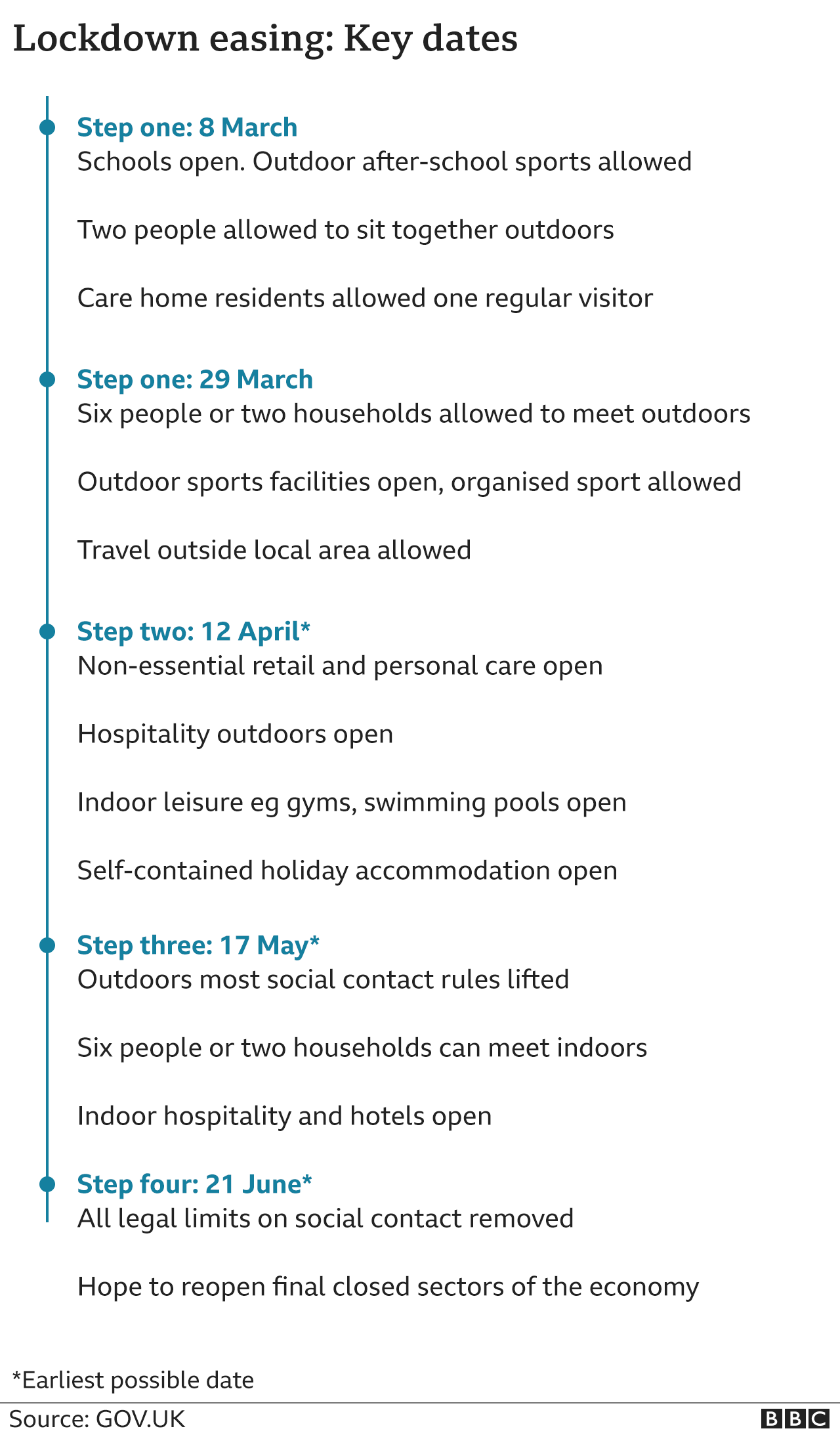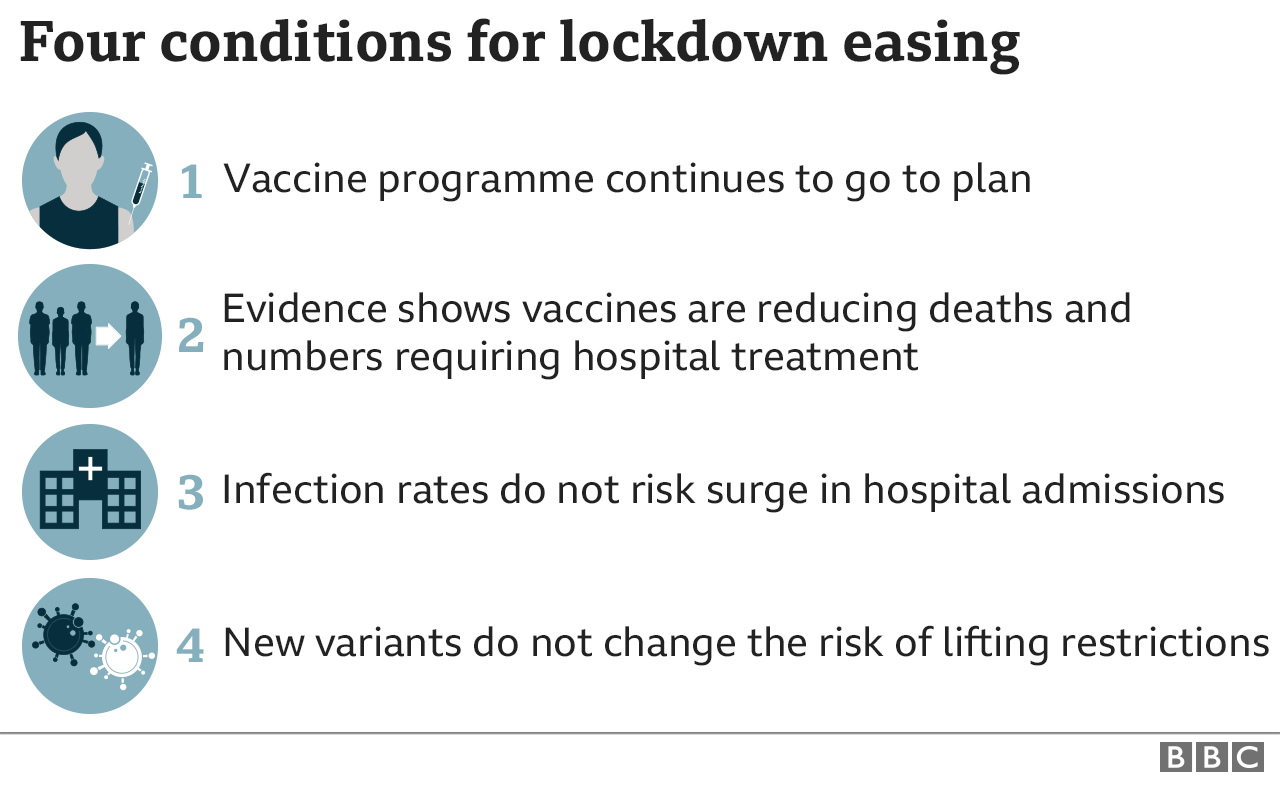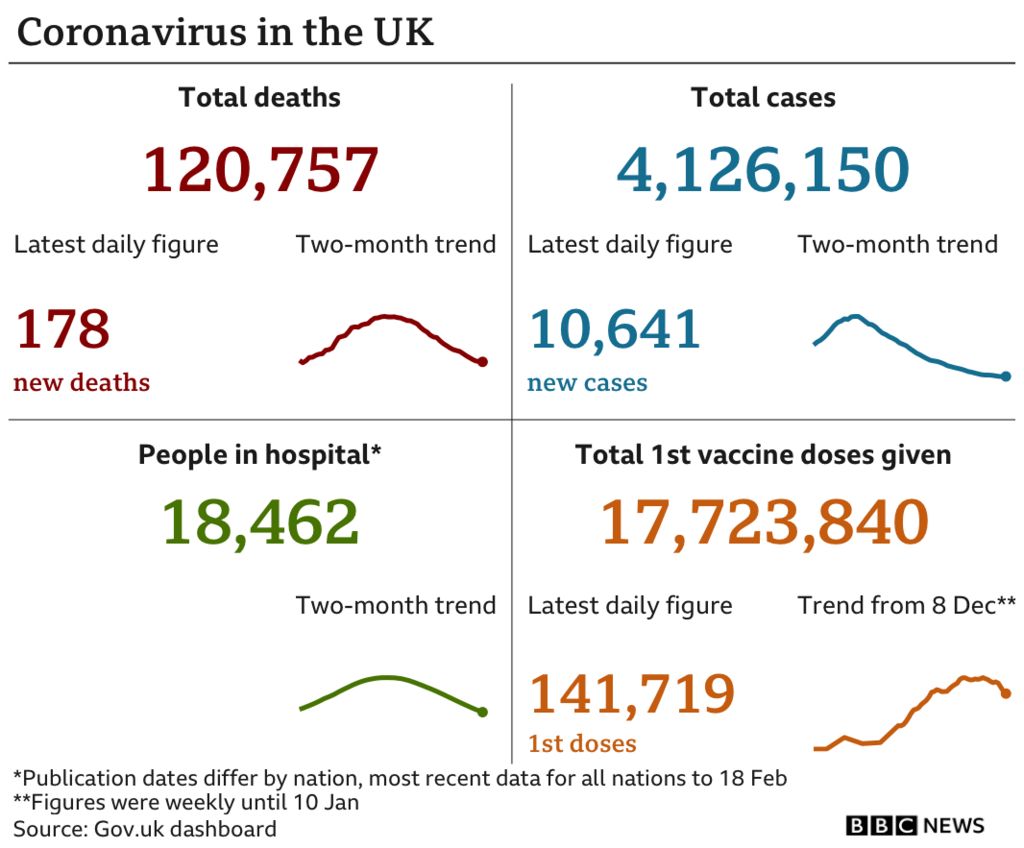Lockdown: Boris Johnson unveils plan to end England restrictions by 21 June
21st of June #21stofJune

media captionWatch the full statement by Boris Johnson on England’s roadmap out of the Covid-19 lockdown.
A new four-step plan to ease England’s lockdown could see all legal limits on social contact lifted by 21 June, if strict conditions are met.
Shops, hairdressers, gyms and outdoor hospitality could reopen on 12 April in England under plans set out by the PM.
From 17 May, two households might be allowed to mix in homes, while the rule of six could apply in places like pubs.
It requires four tests on vaccines, infection rates and new coronavirus variants to be met at each stage.
Prime Minister Boris Johnson told MPs the plan aimed to be “cautious but irreversible” and at every stage decisions would be led by “data not dates”.
There was “no credible route to a zero-Covid Britain nor indeed a zero-Covid world”, he said.
Mr Johnson later told a Downing Street news conference the coming spring and summer would be “seasons of hope, looking and feeling incomparably better for us all”.
He described the plan as a “one-way road to freedom” but said he could not guarantee it would be irreversible “but the intention is that it should be”.
Step-by-step
As part of the first step of the plan for easing lockdown in England:
Secondary school pupils can access tests and will be required to wear face coverings in classrooms and shared spaces like corridors.
There will be a gap of at least five weeks between each of the plan’s subsequent steps to allow for the impact of changes on infection rates and hospital admissions to be assessed.
The second step from 12 April would see major parts of the economy permitted to reopen:
But wider social contact rules will continue to apply in all settings – meaning no indoor mixing between different households will be allowed.
Mr Johnson confirmed the end of hospitality curfews – and requirements to eat a substantial meal alongside alcohol.
He said a review of international leisure travel restrictions would be announced by 12 April at the earliest.

![]()
Funerals continue with up to 30 people, and weddings with up to 15 guests.
The third step will come from 17 May – if the data allows – and will see the “rule of six” abolished for outdoor gatherings, replaced with a limit of 30 people:
Up to 30 people will be able to attend weddings, receptions, funerals and wakes.
Mr Johnson said this step would also “consider the potential role of Covid status certification” – which could refer to so-called “vaccine passports” – in helping indoor venues to reopen safely.
media captionProfessor Chris Whitty explains the length of gaps between each stage of reopening
Before the fourth step, ministers will carry out a review into social distancing and other “long-term measures” designed to reduce transmission, including the “one metre plus” rule and the wearing of face coverings.
They will also consider whether to lift the “work from home” guidance, which the government says people should continue to follow until the review has been completed.
The fourth step from 21 June will potentially see all legal limits on social contact removed, with the final closed sectors of the economy reopened – such as nightclubs.
The government hopes that – from this date – restrictions on weddings and funerals will also be abolished.
Music and events leaders called for more financial support for the sector, with the boss of one live music trade body saying his industry is “at the back of the queue to re-open” once restrictions are lifted.
MPs will vote on the roadmap in late March.

![]()
Labour leader Sir Keir Starmer welcomed the plan but said certainty was needed over the future of the government furlough scheme for both businesses and workers.
media captionSir Patrick Vallance says home-working and mask-wearing measures may continue until next winter
Prof Neil Ferguson, of Imperial College London, said he thought the roadmap struck the “right balance” – but warned reopening schools risks increasing the number of cases reported each day.
Speaking later at the Downing Street briefing, UK chief scientific adviser Sir Patrick Vallance said it was “very important” to leave a gap of five weeks between the changes in the roadmap to avoid “flying blind”.
Sir Patrick also said “baseline” measures – such as face coverings in certain situations, hand washing, and self-isolation – may be necessary next winter.
![]()
Why the caution?

The vaccines are working well and infection levels have fallen five-fold since the start of the year.
So why, many may ask, is there such caution?
The answer lies in the mountain of data published by the government as it unveiled its roadmap.
Among the documents was modelling done by Imperial College London.
It showed a rapid easing of restrictions could lead to surge in deaths over the summer and a total of 80,000 deaths by the middle of 2022.
There is much uncertainty about scenarios like this – for one thing it did not take into account any seasonal impact that the warmer weather could bring by reducing spread of the virus.
The gradual lifting could, by comparison, reduce that to around 30,000. That would bring it in line with the sort of deaths we could see during a bad flu winter.
UK chief medical adviser Prof Chris Whitty says that should be the context in which we judge Covid now.
![]()
The devolved nations have the power to set their own restrictions but have largely moved in the same direction, though at different speeds, during the pandemic.
First Minister Nicola Sturgeon has said Scotland would return to a tiered system of restrictions when lockdown measures are eased.
It means different parts of the country could be under different rules. Ms Sturgeon added that she would set out the likely phases for a gradual lifting of restrictions on Tuesday.


In Wales, First Minister Mark Drakeford has said he hopes the “stay-at-home” requirement could end within three weeks, with some non-essential shops and hairdressers possibly reopening at the same time.
Northern Ireland’s First Minister Arlene Foster wants its executive to discuss the reopening date for schools following Mr Johnson’s announcement in England.
![]()
Some Tory MPs unhappy

The prime minister addressed the 1922 backbench committee of Conservative MPs tonight.
He faced criticism of what some saw as slow progress in removing restrictions.
One participant suggested he was talking “gibberish” when he compared his routemap to a motorway journey.
Another said the PM had been “rattled”.
What annoyed some MPs was an apparent lack of flexibility in the plan with restrictions not being lifted “before” certain dates.
He was urged to keep open the possibility of bringing these dates forward if data allowed but there was “no backtracking” on the five-week wait between steps.
The prime minister also said that “a debate had to be had” on domestic vaccine passport certificates.
![]()
It came as a further 10,641 coronavirus cases were reported on Monday, alongside another 178 deaths within 28 days of a positive test.
More than 17.7 million people across the UK have now received at least one vaccine dose, according to latest government figures.


